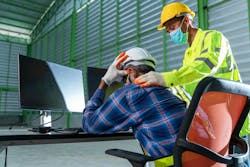Sleepless Over Safety: The Hidden Toll of Workplace Incidents and How to Address It
Safety leadership in industrial settings is demanding by nature. For many professionals in this field, the responsibility does not end with the shift. Even when everything seems in order, incidents—near misses, disrupted workflows and equipment concerns—remain front of mind. That persistent concern, to health and safety managers often invisible to others, carries consequences beyond operations. It affects well-being, mental clarity, and the ability to rest outside of the working environment.
When incidents keep happening because the setup never changes or the controls are outdated, the pressure builds. It is not only compliance at stake, but confidence, and that carries a cost.
The link between near misses and mental fatigue
Each late-night alert, medical response, or shift disruption adds to a growing mental burden. These moments contribute to operational strain but also erode trust across teams. In 2023, the American workplace experienced over 4,500 preventable injury-related deaths and over 4 million medically consulted injuries, according to the National Safety Council (NSC).
But the victims of these accidents are not just those who get injured. These events also affect those directly responsible for preventing them. Continuous stress from the fear of overlooking a risk can result in chronic fatigue. Decision-makers become hyper-alert, and confidence in their safety infrastructure starts to falter. For example, if equipment is hard to reconfigure or cannot adapt to layout changes, the burden only grows.
The mental toll is rarely accounted for in traditional risk assessments. It does not show up in standard metrics, yet the mentality of constant risk anticipation shapes decisions on the ground every day—whether that is delaying maintenance to avoid blame or halting operations out of uncertainty. Health and safety leaders must move beyond reactive approaches with tools that reduce guesswork and restore visibility and flexibility.
When safety infrastructure cannot adapt, risk increases
There is a certain reluctance in reconfiguring traditional, bolted systems, as this often requires costly downtime. As a result, any changes are usually delayed until a close call or worse, forced intervention. That delay has consequences. Workers adapt their behaviors around static infrastructure, finding workarounds that lead to inconsistent and sometimes unsafe routines. As infrastructure fails to reflect reality on the floor, the gap between actual risk and perceived protection widens, leaving health and safety leaders with limited clarity and growing pressure.
NSC data shows construction, transportation and warehousing, and manufacturing are three of the top five industries with the most workplace fatalities, accounting for exactly 50% of all workplace deaths in 2023. These figures underscore the heightened risk in high-movement zones and the imperative need for adequate risk management in these industries.
This issue becomes especially pressing when facilities scale quickly. A layout that works for 20 vehicle movements per hour may become unfit when that volume doubles or triples for Black Friday or Christmas. Without the ability to adapt physical protection (such as safety barriers) quickly and safely, risk compounds go unnoticed. This makes it harder to spot emerging hazards before they escalate.
Flexible protection means fewer sleepless nights
Reducing the personal and operational impact of safety leadership starts with control. Modern modular systems allow for real-time changes with minimal disruption. We are talking about minutes instead of hours or days, because modern barriers are built with advanced materials like polymers and can be transported quickly thanks to their simple installation and low weight.
The thought of collapsing racking is enough to keep anyone awake at night. That is why the market now has racking protection with embedded smart sensors that provide live data on impacts and near misses that identify accident hot spots. These sensors can also monitor vehicle and personnel routes so that walkways can be changed if the data shows the possible risk of an impact.
When infrastructure aligns with actual movement patterns, facilities reduce hesitation and restore worker trust, not only in the systems but in the leadership behind them. Modular safety setups also support agility during audits and inspections.
According to a survey by McKinsey, highly successful agile transformations typically deliver around 30% gains in efficiency, customer satisfaction, employee engagement, and operational performance. This level of agility contributes to performance, but more importantly, to the reputation and standing of the facility and the company that owns it.
Turning passive policies into active prevention
Safety performance cannot depend solely on audits or static policy documents, but rather on data-driven systems that offer continuous insight. Sensors integrated into safety solutions can detect frequent contact points, flag repeated impacts, and identify areas where risks are increasing. This data supports real-time operational adjustments and encourages team-wide engagement. When staff see their feedback inform change—and when data supports those decisions—safety culture becomes proactive. It stops being a checklist and becomes a responsive, evolving system that alleviates pressure on health and safety leaders.
Impact data is a critical input for decision-making in a high-performance facility. Insights on vehicle movement patterns, incident timing and near-miss locations allow leaders to redesign workflows, retrain teams, and confidently reposition safety solutions as needed without compromising performance or targets. Over time, this creates a self-correcting loop where systems and people reinforce each other.
It also enables strategic planning. With a proactive approach to risk management, facilities can forecast future risk based on trends in current data, allocating resources more effectively and avoiding unplanned shutdowns.
Helping leadership see what safety teams already know
Health and safety managers already understand the importance of protective infrastructure. What they often face is hesitation from senior stakeholders who question the need to invest in safety when there has not been a major incident. This resistance can delay planning and upgrades, and leave teams exposed to risks that are entirely foreseeable.
Presenting the financial case becomes a practical way to unlock that buy-in. According to the American Society of Safety Professionals, companies see a return of $4 to $6 for every dollar spent on workplace safety. These returns are visible in reduced downtime and fewer operational stoppages. When conversations with leadership shift toward cost avoidance and risk reduction, investment becomes easier to justify.
Modern safety infrastructure also helps sites remain stable during periods of change. When systems can be adjusted without disruption, teams operate with greater certainty. Also, employees are more likely to stay in roles where they feel protected, with an OSHA-aligned study revealing that strong safety programs boost employee retention rates by up to 55%.
These outcomes help safety managers make a stronger case internally. The goal is not to respond once something goes wrong, but to prevent issues before they emerge. That clarity allows operational focus to remain on performance, rather than recovery.
Peace of mind through proactive protection
No safety leader can prevent every risk, but they can remove the guesswork that keeps risk management reactive. With modular, responsive infrastructure, risk becomes something you can act on, not just monitor. The mental strain often stems from uncertainty about whether protection will hold up under pressure. That strain eases when systems are built to adapt, giving leaders the confidence to focus on what is ahead, not what might go wrong.
Risk management is not only about adding physical barriers, but also about knowing that the solutions in place will work, even if and when demands shift. And that is what lets safety leaders do their job with confidence. To turn off their phone at the end of their shift. To stop scanning the corridor logs at midnight. To know that the infrastructure protecting their teams today will still hold up tomorrow.
About the Author

James Smith
James Smith is co-CEO at A-SAFE. With 25 years of experience in the industry, Smith has transformed this family business into a global enterprise with 700 employees and presence in over 65 countries. Smith is based in West Yorkshire (UK), and specialises in industrial safety innovation, product development, and global market expansion, with a rigorous focus on quality testing standards and a strong passion for building lasting customer relationships.
